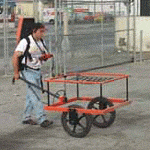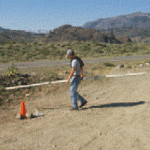Electromagnetic (EM) Surveys
|
|
|
Locating buried metal objects (drums,UST's, utilities, etc.)
|
Delineating contamination plumes
|
|
Defining lateral changes in lithology
|
|
Locating water producing fractures
|
|
|
|
Detecting UXO
|
|
Gathering of forensic evidence
|
Electromagnetic induction (EM), as the name implies, uses the principle of induction to measure the electrical conductivity of the subsurface. A primary alternating electric current of known frequency and magnitude is passed through a sending coil creating a primary magnetic field in the space surrounding the coil, including underground. The eddy currents generated in the ground in turn induce a secondary current in underground conductors which results
in a alternating secondary magnetic field, that is sensed by the receiving coil. The secondary field is distinguished from the primary field by a phase lag. The ratio of the magnitudes of the primary and secondary currents is proportional to the terrain conductivity. The depth of penetration is governed by the coil separation and orientation.
Unlike conventional resistivity techniques, no ground contact is required. This eliminates direct electrical coupling problems and allows much more rapid data acquisition. For shallow profiling (up to 20 feet), a Geonics, Inc. EM-31 Terrain Conductivity meter is used. One person can collect as many as 10,000 data points per day with this instrument. An EM-34 is used for depths of investigation between 30
and 180 feet. This instrument requires two people to operate, and up to 500 data points per day can be collected under good conditions. These tools are extremely sensitive and accurate, capable of detecting variations in conductivity of as little as 3%. Data are automatically stored in an electronic data logger for later transfer to a computer.
 The EM-61 instrument is a high resolution, time-domain device for detecting buried conductive objects. It consists of a powerful transmitter that generates a pulsed primary magnetic field when its coils are energized, which induces eddy currents in nearby conductive objects. The decay of the eddy currents, following the input pulse,
is measured by the coils, which in turn serve as receiver coils. The decay rate is measured for two coils, mounted concentrically, one above the other. By making the measurements at a relatively long time interval (measured in milliseconds) after termination of the primary pulse, the response is nearly independent of the electrical conductivity of the ground. Thus, the instrument is a super-sensitive metal detector. Due to its unique coil arrangement, the response curve is a single well
defined positive peak directly over a buried conductive object. This facilitates quick and accurate location of targets. Conductive objects, to a depth of approximately 10 feet can be detected.
The EM-61 instrument is a high resolution, time-domain device for detecting buried conductive objects. It consists of a powerful transmitter that generates a pulsed primary magnetic field when its coils are energized, which induces eddy currents in nearby conductive objects. The decay of the eddy currents, following the input pulse,
is measured by the coils, which in turn serve as receiver coils. The decay rate is measured for two coils, mounted concentrically, one above the other. By making the measurements at a relatively long time interval (measured in milliseconds) after termination of the primary pulse, the response is nearly independent of the electrical conductivity of the ground. Thus, the instrument is a super-sensitive metal detector. Due to its unique coil arrangement, the response curve is a single well
defined positive peak directly over a buried conductive object. This facilitates quick and accurate location of targets. Conductive objects, to a depth of approximately 10 feet can be detected.
 The EM 31 uses an alternating electromagnetic field, which fills the space, below and above ground, surrounding the transmitting coil. When the electromagnetic field couples with a conductor, for example a steel pipe under the ground, AC eddy currents are induced to flow in the pipe. This generates a secondary magnetic field, which is sensed by the co–planar (12’ offset) receiver
coil. Due to phase lag the computer on board can discriminate between the primary and secondary fields and outputs the measurements of the secondary field (thus, a conductive zone is
The EM 31 uses an alternating electromagnetic field, which fills the space, below and above ground, surrounding the transmitting coil. When the electromagnetic field couples with a conductor, for example a steel pipe under the ground, AC eddy currents are induced to flow in the pipe. This generates a secondary magnetic field, which is sensed by the co–planar (12’ offset) receiver
coil. Due to phase lag the computer on board can discriminate between the primary and secondary fields and outputs the measurements of the secondary field (thus, a conductive zone is
sensed by the induced secondary magnetic field).
